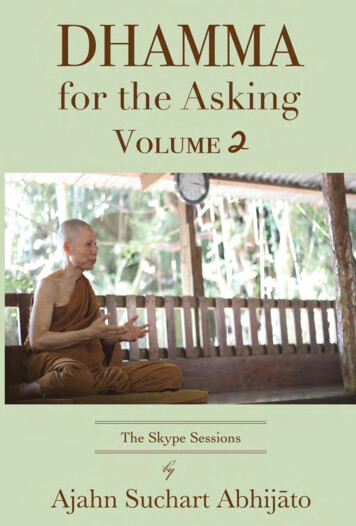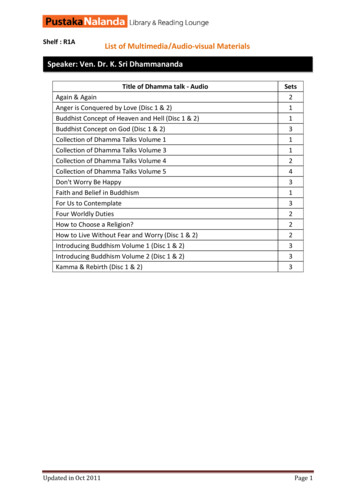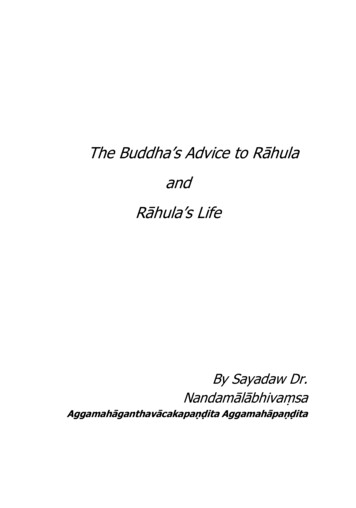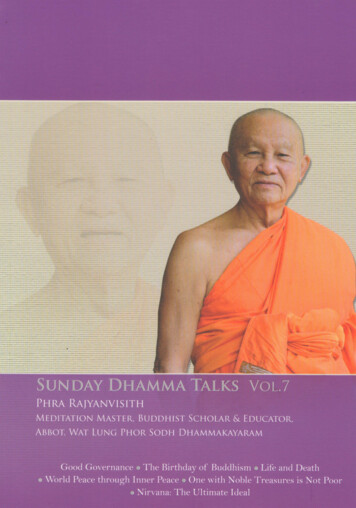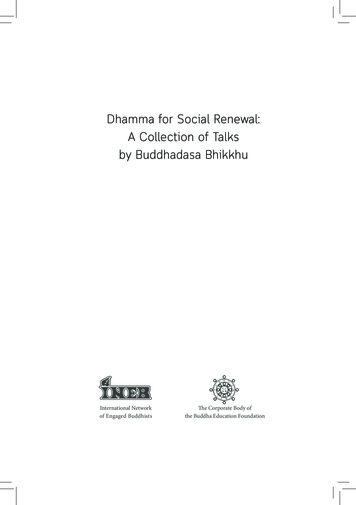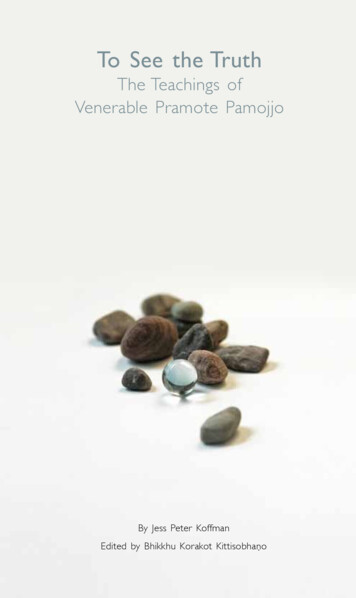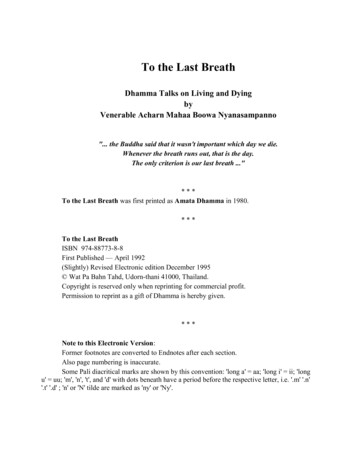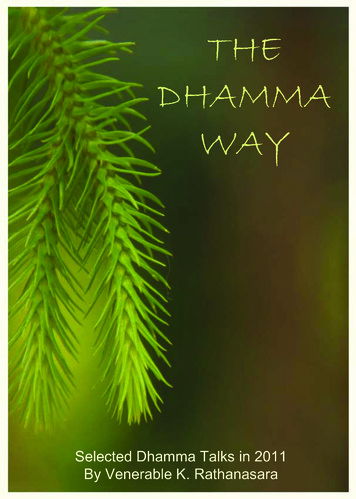
Transcription
Rathanasara
THE DHAMMA WAYSelected Dhamma Talks in 2011byVenerable K. RathanasaraEdited bythong kim-foo (vimutti)
Published for free distribution onlyFirst published in Singapore in 2012ISBN: 978-981-07-3705-4 (Paperback / Softcover)ISBN: 978-981-07-3706-1 (E-Book)E-Book is available at www.dhammaforeveryone.comReprinting of this book for free distribution is encouraged as long asthe publication is reprinted in its entirety with no modifications,including this statement of conditions and we require permission tobe obtained in writing or via email (www.dhammaforeveryone.com)to ensure the latest edition is usedAll rights reserved
Sabbadānaṃ dhammadānaṃ jināti,Sabbaṃ rasaṃ dhammaraso jināti,Sabbaṃ ratiṃ dhammaratī jināti,Taṇhakkhayo sabbadukkhaṃ jināti.The gift of Dhamma surpasses all other giftsThe taste of the Dhamma excels all tastesDelight in the Dhamma excels all delightsThe eradication of Craving overcomes all illsDhammapada Verse 354Sri Lankaramaya Buddhist Temple30C, St. Michael RoadSingapore 328002
Puññaṃ ce puriso kayirāKayirāthetaṃ punappunaṃTamhi chandaṃ kayirāthaSukho puññassa uccayo.A person who does meritorious deeds,repeatedly performs such acts findingpleasures therein; since, accumulation ofmerits conduces to happinessDhammapada Verse 118
ContentsA Word from the Editor 3Foreword 7Why should we practise Mettā? 11How to make Merits? 35Do you cultivate the Four Divine Abodes? 57Q&A on Buddhist’s Misconceptions 73Will Buddhism disappear from the world? 105Have you seen Relics? 123Are there karmically genetic diseases? 139What is the Buddhist approach to crime andpunishment? 159Let’s practise ‘Paccavekkhana’ 177Page 1
Manopubbaṅgamā dhammā,Manoseṭṭhā manomayāManasā ce paduṭṭhena,Bhāsati vā karoti vāTato naṃ dukkhamanvet,Cakkaṃ'va vahato padaṃ.All phenomena (originating from a sentientbeing) dhamma – are preceded by (the activityof) the mind, have as their chief agent, themind; and are made-up of the mind. If onewere to speak or act with a polluted mind,sorrow follows one as a consequence; like thecart-wheel which follows the foot of the ox(that draws the cart)Dhammapada Verse 1Page 2
A Word from the EditorOur teacher, Bhante K. Rathanasara gave Dhamma talks onlast Friday of every month starting from April to December2011 in Sri Lankaramaya Buddhist Temple.During this period of time, i was given the opportunity torecord his talks. It was originally intended to upload these talksto the internet, but due to the sizes of these audio files, theycannot be uploaded to the current capacity of the server.To go round this obstacle, i proposed that the talks betranscripted and uploaded up to the internet as a pdf file whichis deemed an improved alternative, as it will not overload thecapacity of the website. In addition, readers will be able to readand see the texts of the Dhamma talks as well as Pāḷi stanzasthat are uttered by Bhante during his talks.On 24 March 2012, i attended the Buddhist Symposium “Dhamma in Action: Here and Now” that was organized byThe Buddhist & Pāḷi College of Singapore and its Alumni,together with partners Mangala Vihara Buddhist Temple andTi-Sarana Buddhist Association. This Symposium is held inconjunction with the 80th birthday celebration of the MostVenerable, Dr. Pategama Gnanarama Anu-Nāyaka Mahātheraand a book was also released in his honour.Drawing upon this inspiration, it occurred to me that theDhamma talks given by our teacher in 2011, which has alreadyPage 3
been transcripted, should be released as a book version, as aform of respect from a student to his teacher.But to release in a book version, the content mustgrammatically be corrected as well as quoted Pāḷi sentencesand language structures must be verified, corrected andreference to the Pāḷi Tipikata.Here, i would like to thank Sister Karen Tan (Samadhi), SisterLee Soh Hong, Sister Yeoh Suh Ning (Anupassi), Sister LindaGoh and Brother Darren Leow for their helps, patience andhard-work in the vetting and correction processes. i would alsolike to thank Sister Kathrine Zee (Santhutti) for her help inproof-reading these talks. In addition, the picture and design ofthis beautiful book cover is taken and designed by Sister LindaGoh and Brother Darren Leow respectively. i must also thankmy wife, Dorothy Tan (Sumana) who had unreservedlysupported the entire process of this book release, starting fromthe transcript phase on providing advice on proper terms to beused, font and size to be used till the final book phase on proofreading of the selected contents. Finally, i must thankProfessor Chandima Wijebandara who taught me in myPostgraduate Diploma Course in Fundamental BuddhistStudies and my current Masters of Arts degree (BuddhistStudies) in reviewing and correcting all the Pāḷi stanzas andterms used.Without all their helps, this book on "Selected Dhamma Talksin 2011 by Venerable Rathanasara" will only remain as anidea. It is through their selfless help that this book can beprinted and see the light of day.Page 4
Despite our best efforts, we believe that there will still beerrors contained in this release. If you do spot any error(s), weappreciate very much your feedback through the contact pageof the website (www.dhammaforeveryone.com) and willupdate the corrections in subsequent reprints and e-bookversion.May all be well and happy.thong kim-foo (vimutti)October 2012Page 5
Manopubbaṅgamā dhammā,Manoseṭṭhā manomayā,Manasā ce pasannena,Bhāsati vā karoti vā,Tato naṃ sukhamanveti,Chāyā'va anapāyinī.All phenomena (originating from a sentientbeing) dhamma – are preceded by (the activityof) the mind, have as their chief agent, themind; and are made-up of the mind. If onewere to speak or act with a pure mind,happiness follows one as a consequence, like ashadow that never leaves oneDhammapada Verse 2Page 6
ForewordCommunicating Buddhism is not an easy task. It is a verydifferent challenge from giving a sermon to a believing,faithful, and non-questioning congregation. The very nature ofBuddhist Philosophy and religion anticipates challengingaudiences. It is a religion tagged “come and see”; not “comeand believe”. It has never thought of silent audiences full of‘yes’ men. Platforms of Dhamma talks are scenarios of toughquestions, challenges and expressions of disbelief whereknowledgeable communicators attempt to convincesophisticated audiences of the scientific, rational, practical andmodern characteristics of Buddhism.On the other hand the Buddha himself has shown initialreluctance in communicating Dhamma for different reasons.He realized that the very nature of the message is going againstthe grain. It is an invitation to control lust and greed whilepeople in general are obsessed with lust, burning with it, yetenjoying it. And even after deciding to teach, having focusedon people with little dust in their eyes, he had to filter someunsuitable people out. For instance, those who had very strongdogmas drilled into their hearts who refuse to open their mindsfor new insights and who had unprofitable questions to ask outof metaphysical interests were left out. Moreover, Buddhism isneither meant to be an academic burden, nor a dogma to grabtight. Practice of it requires vigorous investigation andconviction that it leads to practical benefits. A communicator,therefore, has to expect a difficult audience aggressivelychallenging, demanding, yet genuine. It may be the veryPage 7
reason that Mahayana Buddhists added Upaya Kausalya (theskill in means of communicating) into their list of Pāramitās ata later date.In this collection of talks by Venerable K.Rathanasara, wemeet a skillful communicator attempting to communicate theteachings of the Buddha to a significantly different audiencefrom that it was originally presented to. Even thoughtimelessness (akālika) of the evergreen teachings of Gotamathe Buddha has given him enormous confidence, heundoubtedly had to encounter confused audiences exposed tovaried cultural norms and scientific, consumerist andsometimes ultra-mundane elements. He seems to have facedwith the challenge of clearing misunderstandings, correctingdistortions and deal with criticisms throughout his sermons andQ&A sessions.Venerable Rathanasara’s sermons, recorded and edited for thiscollection by his highly competent editor, cover a wide rangeof subjects from moral actions (Kamma) to the future ofBuddhist religion. Topics like Five Precepts, Merit Making,Relic Worship and Meditation are of practical importance toBuddhists. Yet, not limiting to inclusive issues, VenerableRathanasara has dealt subjects with wider relevance andcontemporary appeal, like crime and punishment. His Q&Asessions had been more thought provoking and encouragingfor further delving into the Buddha’s teachings. Though deeplyrooted in Early Buddhism, as a genuine Theravāda monk hasto be, Ven. Rathanasara has spoken without prejudice to anyother tradition or religion. And he has displayed magnanimity,broadmindedness and understanding in discussing culturallyPage 8
sensitive issues. His deep analytic wisdom is sufficiently lacedwith warm humanitarian spirit and sincere compassion.His editor, Vimutti Thong has done a marvelous job, takingcare of fine intricacies of subject matter and annotating thesermons when he managed to find original sources, and beingfaithful to Pāḷi terms the speaker has frequently used. I knowthat this collection sees the light of the day owing to hisfaithful, sincere and positive interest shown from the day hehimself mooted the concept, getting kind approval fromVenerable Rathanasara. I am sure the Buddhists all over theworld who were fortunate to have audience with this promisingyoung monk who has earned international fame within a veryshort time, would feel extremely grateful to the editor for theexcellent gift of Dhamma he has enthusiastically produced.Professor Chandima Wijebandara(Former Vice Chancellor of Sri Jayewardenepura University, Sri Lanka.Resident Professor of Pāḷi and Buddhist Studies, BRS/BL Graduate Schoolof Buddhist Studies, Singapore.)Page 9
Yathāpi ppupharāsimhā,Kayirā mālākuṇe bahū,Evaṃ jātena maccena,Kattabbaṃ kusalaṃ bahuṃ.Just as many garlands are made from a heapof flowers, so should one born to this world,should do much meritDhammapada Verse 53Page 10
Why should we practiseMettā?Date: 15 April 2011Time:8:30 pm to 10:00 pmVenue: Reclining Buddha Shrine HallSri Lankaramaya Buddhist TempleSingaporePage 11
Sahassampi ce vācāAnatthapadasaṃhitāEkaṃ atthapadaṃ seyyoYaṃ sutvā upasammati.Better than a thousand useless words is oneuseful word, hearing which one attains peaceDhammapada Verse 100Page 12
SynopsisA monk was bitten by a snake,And he died on the spot.Having heard the news Buddha said:“O Monks, that monk did not practise loving-kindness. If thatmonk practised loving-kindness, he would not have died beingbitten by a snake”.What is Mettā?Why should we practise Mettā?Buddha said:“Just as in the last month of the rainy season in autumn, whenthe sky is clear and free of clouds, the sun, on ascending,dispels the darkness of space and shines forth, bright andbrilliant. Even so, whatever grounds there are for making meritproductive of a future birth, all these do not equal a sixteenthpart of the liberation of mind by loving-kindness”.There are eleven great benefits that one can enjoy bypracticing Mettā. The benefits are immediate and visible.Mettā technique is such that there is no special posture, placeor time. It is flexible and available at your wish. It does notrequire a fixed duration of time.So for those who have time or otherwise, you can stillmeditate.Page 13
Mā'pamaññetha pāpassaNa mantaṃ āgamissatiUdabindunipātenaUdakumbho'pi pūratiPūrati bālo pāpassaThokathokampi ācinaṃThink not lightly of evil, saying,"It will not come to me."Drop by drop is the water pot filled.Likewise, the fool, gathering it little by little,fills himself with evil.Dhammapada Verse 121Page 14
We chant Metta Sutta almost every day. And in most Dhammatalks, we start with Mettā Meditation. Am I correct? Mettā isso common and popular that people misunderstand andmisinterpret it to be a very simple type of meditation.Sometimes we underestimate the power and benefits of MettāMeditation. Last week, I overheard a conversation betweentwo devotees in the temple under the Bodhi tree. One of themwas practicing Mettā Meditation and the other was practisingthe meditation technique relating to the Five Aggregates. Thenthe one who practised the meditation technique relating to theFive Aggregates said, “Mettā Meditation is so simple, that it isonly for beginners or those at kindergarten level. You shouldpractise the higher type of meditation.” This misinterpretationis probably due to the lack of understanding of the Dhamma.Friends, all meditation techniques that are taught in Buddhismare equally important. They serve a purpose. We shouldneither discriminate against any of the Buddhist meditationtechniques, nor argue about the good and bad, as they are allequally important and just as beneficial. These meditationtechniques allow people of various characters andtemperaments to achieve different purposes.First of all, it is very important for you to understand Mettābefore you can radiate Mettā. The word “Mettā” comes fromthe Pāḷi language, which simply means love. However, this isnot the kind of ordinary love defined in the English dictionary.Mettā is translated into English by some scholars as ‘lovingkindness’. So, what is the difference between ‘love’ and“loving-kindness”?Page 15
The love that we commonly speak about has greed, hatred anddelusion as hidden tendencies. The love between a man andwoman, husband and wife, brother and sister, friends, parentsand children – such love comes together with greed, lust,hatred, ill-will, jealousy, anger, ignorance and delusion. Theseare considered defilements. Buddhism recognises greed, hatredand delusion as the 3 main roots of defilements. That is whythere are instances where people in relationships, such as thatbetween a husband and wife or two lovers, can go to the extentof harming or killing each other when they break up, as theseactions arise from hatred. Hence Buddhism does not recognisethis commonly spoken love as “Mettā”.What about the purest love that we recognise, like mother’slove? Mother’s love is the purest love we all know and Buddhatalked of this highly appreciative love, but Buddhism does notrecognise it as the purest love. The love of a mother is stilltainted with greed, hatred and delusion. A mother can love herson so much, but may not love her neighbour’s son in the sameway. This is due to the mother’s attachment to the child. Whenthe child does not behave in the manner that pleases his/hermother or follow instruction properly, the disappointed mothergets angry. There are even parents who would say extremelyhurting remarks such as “I do not want to see you anymore!”or “You are no longer my son/daughter!” Such love betweenmother and child is not to be called Mettā.So, what does “Mettā” mean? Mettā is love which does notcontain any greed, hatred, delusion, lust or other defilements,and is cultivated based on wisdom, compassion, goodwill andbeneficial thoughts. Every person is born in this world with thePage 16
ability to love. However, Mettā is not the ordinary type of lovewhich has emotional, sentimental or sensual elements butrather; it is a sublime type of thoughts which has to becultivated. Mettā together with Karuṇā (compassion), Muditā(appreciative joy) and Upekkhā (equanimity) form the foursublime qualities of the human mind.What is Mettā bhāvanā or Mettā Meditation then? We all havethe seeds to develop Mettā. But if you do not plant the seed bygiving it soil, water, sunlight and manure, it is not possible forthis seed to grow. On the other hand, if you plant this seedwell and take care of it, it will grow into a plant. So friends, allof us have the seeds to develop the four sublime qualities ofthe human mind.At the beginning of the widely chanted Metta Sutta, theBuddha described the qualities that you should cultivate todevelop Mettā. How should we prepare ourselves to cultivateMettā?Sakkō ujū ca sūjū ca1Suvaco cassa mudu anatimānīSantussakō ca subharō caIn cultivating Mettā, one has to be honest, sincere, humble,upright and uphold righteous principles in your life. Oneshould not be extremely busy to such an extent that one has notime for spiritual development. Lastly, he or she should besomeone who has little demands for material needs. These are1Karaniya Metta SuttaPage 17
the qualities required to prepare the ground in developingMettā.Why should we cultivate and practise Mettā?The Buddha said very clearly, “Mettā is the foundation for allmerits.” There is nothing comparable to Mettā. Today, I havegiven you some notes on three discourses. In the firstdiscourse, the Buddha emphasised on the importance ofmeritorious deeds. He said, “Monks, whatever grounds thereare for making merits which are productive towards a futurebirth, all these do not equal to a sixteenth part of the liberationof mind by loving-kindness. The liberation of mind bypractising loving-kindness surpasses them and shines forth,bright and brilliant.”And He gave an example: “Just as the radiance of all the starsdoes not equal to a sixteenth part of the moon’s radiance, themoon’s radiance surpasses them and shines forth, bright andbrilliant. Likewise, making all merits which are productive forfuture birth does not equal to a sixteenth part of the liberationof the mind by practicing loving kindness.” The Buddhaexplained here how important Mettā is for those who needmerits. Therefore, one cannot make merits without Mettā.Merit is described as the wholesome karmic energy whicharises in one’s mind through wholesome actions. ThroughMettā meditation, the mind becomes wholesome, full of lovewith compassionate thoughts and loving-kindness. Based onthese wholesome positive thoughts, words and actions becomewholesome. When one does a good deed or a wholesomePage 18
action with a positive mind, he or she will generate a positiveenergy known as merit. Merit is required for all sentient beingswithin the cycle of existence.Puññāni paralokasmin pātiṭṭha honti paninam2Merits naturally yield happiness to all beings. In the process ofwandering from one realm to another, it is the merits that willpave the way for one to be born in a pleasurable andfavourable realm. From the Buddhists’ perspective, all of ushave generated merits in our past lives, which explain why weare born as human beings today. Pubbe ca kata-puññatā3 ‘to have done merits in the past’ is a blessing.So long as enlightenment is not achieved, merits will alwaysbe required. After enlightenment, merits are not requiredanymore because there will be no rebirth.The Buddha said, “Pabbajitassapi upakārāni puññānīti4”.Even the monks and nuns need merits. Whether for monks,nuns or lay people, merits are required. Hence, Mettā isconstantly practised as it is the ground for all merits.And the Buddha said,“Manopubbaṅgamā dhammāmanoseṭṭhā manomayā5”The mind is the forerunner for everything. Mettā is alsopractised because it can weaken hatred. Hatred has a very2Piyehi Vippayogo (Reflection on the Loss of Loved Ones)Mangala Sutta4AN III utf85Dhammapada Verse 1, Cakkhupalatthera Vatthu3Page 19
powerful destructing power on our minds. It is out of hatredthat all evil, wicked, immoral, unwholesome and violentactions come forth. Jealousy, ill-will, anger – though withdifferent meanings, they share the same root of hatred. Onecould easily destroy themselves and others due to hatred,producing considerable negative karmic energies. ThereforeMettā is a very powerful tool to effectively weaken andsuppress the power of this destructive, negative energy linkedto hatred.Mettā is best for people who lose their temper easily. Whenone looks for monks for meditation instructions especially inmeditation centres, meditation techniques are not taughtimmediately. The meditation master will give certaintechniques of meditation to practise and then makeobservations on the person’s character through actions such aswalking, talking, behaviour and attitude to assess the kind ofmeditation suitable for the particular individual.Mettā is a powerful force for one’s own protection. And thereare four types of protective meditation in Buddhism.1. Buddhānusati - contemplation on the virtues of the Buddha2. Mettānusati - loving-kindness for all worldly beings3. Asubbanusati - recollection on the repulsiveness of the body4. Maranānusati - mindfulness of deathThey are called “Caturārakkā-kammaṭhāna” - the four kinds ofprotective meditation.Buddhānusati refers to the recollection of the Buddha. Why isBuddhānusati Meditation protective? Buddhānusati MeditationPage 20
leads to the development of right vision and rightunderstanding in the Buddha’s nature. With the mind focusedin becoming a Buddha - the Enlightened One, one’s thoughts,words, actions are directed to becoming enlightened and henceis protected against evil, wicked, unwholesome thoughts,words and behaviour.Mettā Meditation is also a protective meditation as it helps toreduce the negative power of hatred in the human mind. Ithelps to protect one from hatred and many other dangers fromunseen beings, living beings, human beings and unseen danger.Asubba Meditation is the recollection on the repulsiveness ofthe body, but I will not go into details here. It helps to reducelust, greed and attachment in one’s mind. These three evildefilements are the root causes of suffering.Meditation on death enables one to become energetic, diligentin work and protects one against all defilements and achievesfreedom from the cycle of existence.You may refer to Khanda Paritta which described what tookplace during the Buddha’s stay in Jetavana Monastery in thecity of Sāvatthi. One day, a monk was bitten by a verypoisonous snake and died on the spot. All the other monkscame to the Buddha and reported, “Venerable Sir, so and sodied because of a snake bite.” Then the Buddha said, “Monks,that monk did not practise loving-kindness. He did not radiateMettā towards the snakes and the other living beings. If he hadpractised Mettā, he would not have died as he would not havebeen bitten by the snake. From today onwards, all of you mustPage 21
practise Mettā.” Thus, after this incident, the Buddha made itcompulsory for all Buddhist monks and nuns to practise Mettā.Lay people should also practise Mettā regardless of where theylive, especially for those living in the forest. It is their principaldefence since they do not carry guns and any other weaponsfor their own protection while they live among poisonoussnakes and dangerous animals like leopards and lions. Theywill not be harmed because they cultivated Mettā for their ownprotection.Perhaps all of you know why the Buddha taught the MettaSutta? This is a very well-known story of why the Buddhataught Metta Sutta to the monks. A group of monks wanted topractise meditation and went to the Buddha who advised themto go to the forest for their practice. But when they werepracticing meditation, they were constantly disturbed by someunseen beings and could not concentrate well. The momentthey achieved serenity and concentration, the beings wouldappear in their mind to disturb and frighten them. These monksfound it very difficult to practise meditation and went back tothe Buddha. They asked, “Venerable Sir, we cannot practiseover there because we faced this very unusual type ofdifficulty. We do not understand who they are, why they cometo disturb us in many ways throughout day and night.” TheBuddha said, “Well, learn this Karaniya Metta Sutta (which isnow widely known as Metta Sutta).” The Buddha taught thisdiscourse to the monks and instructed them, “Go there and firstpractise Mettā Meditation. After that, all of you must practiseVipassanā Meditation (Insight Meditation).” These monks thenreturned to the same place to practise Mettā Meditation. Whilepracticing, the loving thoughts and radiation of lovingPage 22
kindness surrounded and permeated all around, and theseunseen beings became friendly and stopped disturbing them.Instead, these unseen beings gave all possible assistance theycould to help the monks. From then on, Metta Sutta is chantedfor one’s own protection.In the Mettānisaṃa Sutta6, the Buddha explained theadvantages of practising Mettā. He gave 11 benefits that onecan achieve and enjoy in this lifetime by practising Mettā.They are:1. Sukhaṃ supati2. Sukhaṃ paṭibujjhati3. Na pāpakaṃ supinaṃ passati4. Manussānaṃ piyo hoti5. Amanussānaṃ piyo hoti6. Devatā rakkhanti7. Nāssa aggī vā visaṃ vā satthaṃ vā kamati8. Tuvaṭaṃ cittaṃ samādhiyati9. Mukhavaṇṇo vippasīdati10. Asammūḷho kālaṃ karoti11. Uttariṃ appaṭivijjhanto brahmalokūpago hoti1. Sukhaṃ supatiThe Buddha explained that one who practises Mettā sleepspeacefully. Friends, don’t you think it is a benefit? There arehundreds of thousands of people who cannot sleep every night.Some go to the doctor asking for sleeping pills and tablets.Some visit pubs and drink alcohol to make themselves sleepy.6AN 11.16; PTS: A v 342Page 23
Not many can have peaceful sleep every day due to stress andother problems. The Buddha guaranteed that one can sleeppeacefully if Mettā Meditation is being practised.2. Sukhaṃ paṭibujjhatiIf Mettā meditation is practised every morning and at bedtime,one’s mind is full of Mettā thoughts. This leads to one wakingup in comfort and feeling refreshed mentally and physically. Itis because when one has slept well, the body and mind is fullyrested.3. Na pāpakaṃ supinaṃ passatiThe third benefit – there will be no evil dreams. Friends,dreams are mental creation. While we are living, we alsodream. Daydream! Sometimes we speculate about our future.Am I correct? We have lots of dreams about our future. Sowhat happen when you are asleep? The same thing will appearas dreams. One very famous psychologist named Dr SigmundFreud said dreams come as emotional roots and are released indreams. Buddhism also speaks of the same thing. What we calla dream is nothing more than our mental creation. There are nodoubts there are certain dreams which are related to specialsense perception, but most dreams are created by the humanmind. When the mind is free from hatred, ill-will, jealousy andanger, there is no way for evil or unwholesome dreams toappear in one’s sleep. If there is any possibility for dreams toarise, then it should only be sweet dreams because the mind isfull of sweet thoughts - a lot of Mettā.Page 24
4. Manussānaṃ piyo hotiOne is dear to human beings. Due to a lack of Mettā, it isdifficult to be among fellow human beings as one gets angryand quarrel easily with others. With Mettā, one becomes apeace-loving and kind person. Friends, because minds are sopowerful, people can feel and sense it. This explains why aperson is being well-liked by others due to that individual’smind being devoid of evil and unwholesome thoughts, whilefilling it with compassion, goodwill and friendship. Words arealso spoken with friendliness, without lies and harshness.When one’s actions become agreeable with others, he or shebecomes a noble human being in society whom everyone likes.5. Amanussānaṃ piyo hotiOne is dear to non-human beings and unseen beings. Who arethese non-human beings and unseen beings? The unseenbeings must not be mistaken as hungry ghosts, and non-humanbeings include animals. When one gets angry, even pet dogsand cats run away because they sense it. But when one emitskind and friendly energies, they will come close and want youto touch them. This is nature. When we were young, after ourdaily breakfast or lunch, we would bring some bananas or fruitfor squirrels and birds when they came by. While they wereeating, we talked to them in good words. They heard our voiceand very quickly they became our friends. They would comenear us for feeding and were no longer afraid of us. Monkswho live in the forest do not have any weapon. They have onlyMettā as protection. There is rarely any report on monks ornuns or a lay person who lives in the forest practising Mettāand was attacked by animals.Page 25
Perhaps you have heard about the incident which happenedduring the Buddha’s time. Have you heard about Devadatta,the Buddha’s cousin? He tried to kill the Buddha many timesby sending professional killers. What happened to theseprofessional killers? The moment they came across theBuddha, they were tamed, threw away their weapons, listenedto the Buddha and became his disciples. Some of them evenbecame monks. One day Devadatta, with the support of KingAjātasattu, used an elephant named Nālāgiri which was wellknown for its violent behaviour in the kingdom, to attack theBuddha. This type of elephant was used in battlefields againstenemies and was the most violent kind amongst those in thekingdom of King Ajatasattu. The caretakers of this elephantused to make it drink toddy (a type of palm wine) so it becamemore violent. Devadatta took the opportunity to make thiselephant Nālāgiri drank toddy and sent it to kill the Buddhawhile he was making his alms round in the city of Sāvatthi. So,what happened? Everyone started screaming and running fortheir lives. The elephant was coming to kill the Buddha andVenerable Ānanda tried to protect the Buddha. But knowingthe nature of Nālāgiri, the Buddha prevented him from doingso. How did the Buddha protect himself? He radiated Hisloving-kindness. Instantly, this wild elephant kneeled down infront of the Buddha and became tamed. This incident came tobe known as Nālāgiridamana (taming the elephant Nālāgiri).Do you th
THE DHAMMA WAY Selected Dhamma Talks in 2011 by Venerable K. Rathanasara Edited by thong kim-foo (vimutti) Published for free distribution only First published in Singapore in 2012 ISBN: 978-981-07-3705-4
